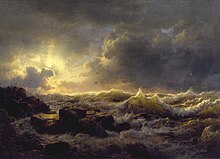Our website is made possible by displaying online advertisements to our visitors.
Please consider supporting us by disabling your ad blocker.
Sturm und Drang
This article needs additional citations for verification. (January 2017) |

Sturm und Drang (/ˌʃtʊərm ʊnt ˈdræŋ, - ˈdrɑːŋ/,[1] German: [ˈʃtʊʁm ʔʊnt ˈdʁaŋ]; usually translated as "storm and stress"[2]) was a proto-Romantic movement in German literature and music that occurred between the late 1760s and early 1780s. Within the movement, individual subjectivity and, in particular, extremes of emotion were given free expression in reaction to the perceived constraints of rationalism imposed by the Enlightenment and associated aesthetic movements. The period is named after Friedrich Maximilian Klinger's play of the same name, which was first performed by Abel Seyler's famed theatrical company in 1777.
The philosopher Johann Georg Hamann is associated with Sturm und Drang; other significant figures were Johann Anton Leisewitz, Jakob Michael Reinhold Lenz, H. L. Wagner, and Friedrich Maximilian Klinger. Johann Wolfgang von Goethe and Friedrich Schiller were notable proponents of the movement early in their lives, although they ended their period of association with it by initiating what would become Weimar Classicism.
- ^ Wells, John (3 April 2008). Longman Pronunciation Dictionary (3rd ed.). Pearson Longman. ISBN 978-1-4058-8118-0.
- ^ E.g. HB Garland, Storm and Stress (London, 1952); German Drang literally translates to throng, and has the sense of "impulse, urge, pressure, stress; longing, desire".
Previous Page Next Page


